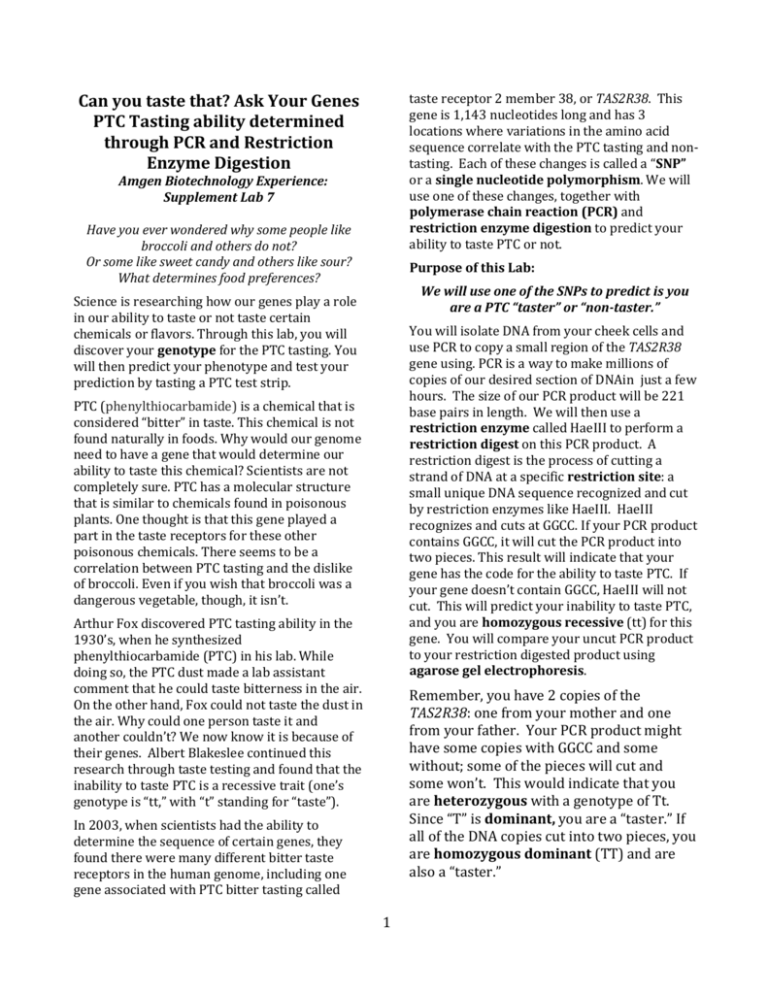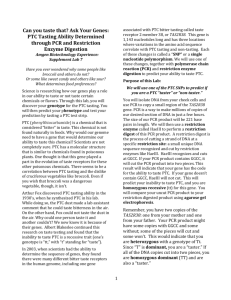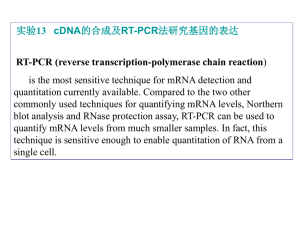Restriction Digest of PCR Product
advertisement

Can you taste that? Ask Your Genes PTC Tasting ability determined through PCR and Restriction Enzyme Digestion taste receptor 2 member 38, or TAS2R38. This gene is 1,143 nucleotides long and has 3 locations where variations in the amino acid sequence correlate with the PTC tasting and nontasting. Each of these changes is called a “SNP” or a single nucleotide polymorphism. We will use one of these changes, together with polymerase chain reaction (PCR) and restriction enzyme digestion to predict your ability to taste PTC or not. Amgen Biotechnology Experience: Supplement Lab 7 Have you ever wondered why some people like broccoli and others do not? Or some like sweet candy and others like sour? What determines food preferences? Purpose of this Lab: We will use one of the SNPs to predict is you are a PTC “taster” or “non-taster.” Science is researching how our genes play a role in our ability to taste or not taste certain chemicals or flavors. Through this lab, you will discover your genotype for the PTC tasting. You will then predict your phenotype and test your prediction by tasting a PTC test strip. You will isolate DNA from your cheek cells and use PCR to copy a small region of the TAS2R38 gene using. PCR is a way to make millions of copies of our desired section of DNAin just a few hours. The size of our PCR product will be 221 base pairs in length. We will then use a restriction enzyme called HaeIII to perform a restriction digest on this PCR product. A restriction digest is the process of cutting a strand of DNA at a specific restriction site: a small unique DNA sequence recognized and cut by restriction enzymes like HaeIII. HaeIII recognizes and cuts at GGCC. If your PCR product contains GGCC, it will cut the PCR product into two pieces. This result will indicate that your gene has the code for the ability to taste PTC. If your gene doesn’t contain GGCC, HaeIII will not cut. This will predict your inability to taste PTC, and you are homozygous recessive (tt) for this gene. You will compare your uncut PCR product to your restriction digested product using agarose gel electrophoresis. PTC (phenylthiocarbamide) is a chemical that is considered “bitter” in taste. This chemical is not found naturally in foods. Why would our genome need to have a gene that would determine our ability to taste this chemical? Scientists are not completely sure. PTC has a molecular structure that is similar to chemicals found in poisonous plants. One thought is that this gene played a part in the taste receptors for these other poisonous chemicals. There seems to be a correlation between PTC tasting and the dislike of broccoli. Even if you wish that broccoli was a dangerous vegetable, though, it isn’t. Arthur Fox discovered PTC tasting ability in the 1930’s, when he synthesized phenylthiocarbamide (PTC) in his lab. While doing so, the PTC dust made a lab assistant comment that he could taste bitterness in the air. On the other hand, Fox could not taste the dust in the air. Why could one person taste it and another couldn’t? We now know it is because of their genes. Albert Blakeslee continued this research through taste testing and found that the inability to taste PTC is a recessive trait (one’s genotype is “tt,” with “t” standing for “taste”). Remember, you have 2 copies of the TAS2R38: one from your mother and one from your father. Your PCR product might have some copies with GGCC and some without; some of the pieces will cut and some won’t. This would indicate that you are heterozygous with a genotype of Tt. Since “T” is dominant, you are a “taster.” If all of the DNA copies cut into two pieces, you are homozygous dominant (TT) and are also a “taster.” In 2003, when scientists had the ability to determine the sequence of certain genes, they found there were many different bitter taste receptors in the human genome, including one gene associated with PTC bitter tasting called 1 Day 1: Isolating your DNA Reagents: 0.9% saline solution, 5 mL 10% chelex solution, 0.5ml 1) Label two microtubes and a cup of saline solution with your identity number given to you by your teacher. Supplies and Materials: Sharpie for labeling Paper cup for saline solution and spit collection Micropipettes and tips 1.5 ml microtubes Centrifuge: both mini and spectrafuge. Hot Block at 99C degrees Vortexer 2) Pour saline solution in your mouth and vigorously rinse your cheeks for 1 minute. 3) Expel the saline solution back into the cup. 4) Carefully, over the garbage or a sink, pour your spit and saline solution into your microtube. 5) Close the microtube tightly and put it into the spectrafuge (high powered microcentrifuge) and spin it for 5 minutes at 10,000 rpm. 6) Look for a cell pellet at the bottom of the tube and carefully pour the liquid above the pellet (supernatant) into a waste container and keep the cell pellet in the tube. 7) Pipette 250 l of 10% chelex into your microtube and resuspend the cell pellet by vortexing or mixing the solution up and down in the pipette. 8) Once resuspended fully, close the tube lid tightly and poke a hole in the top of the lid using a tack. 9) Place the tube in the 99o hot block for 10 minutes. 10) Resuspend the solution one more time and then spin in the spectrafuge for 2-5 minutes so the Chelex beads fall to the bottom of the tube. 11) Without disturbing the beads at the bottom, pipette about 50 l of the solution into second tube labeled with your name and the date. This is your extracted DNA. Your teacher will freeze your tube for you to use in your next experiment. 2 Day 2: Performing PCR Reagents: Master Mix Your isolated DNA Primers in a PCR tube Supplies and Materials: Sharpie for labeling Micropipettes and tips Minifuge with pcr adapter Vortexer 1) Keep PCR tubes on ice. Label a PCR tube with your identity number and then put it back on ice. 2) Obtain your DNA tube from your teacher and carefully thaw it on the countertop. 3) Pipette 5 l of your DNA into your PCR tube. 4) Come up to front of room with your 20 l pipette set at 20 l and with a fresh tip. Pipette 20 l of Master Mix from the teacher’s stock tube into your PCR tube. 5) Return to your seat and quickly cap and vortex your PCR tube and then spin it down in the minicentrifuge. 6) Bring your PCR tube to the PCR machine and put your tube in the ice container (if your teacher is waiting for other student tubes) or put your tube directly in the PCR machine. 7) Your teacher will run the PCR machine once all tubes are in the PCR machine. ** Hint: Work carefully and quickly to get this done. The Master Mix is temperature- and time-sensitive.** 3 Day 3: Restriction Digest of PCR Product Reagents: PCR Product Shared tube of HaeIII (10ul total) 2.5 Restriction Buffer Supplies and Materials: Sharpie for labeling Micropipettes and tips Microtubes Minifuge with pcr adapter and microtube adapter Vortexer Waterbath at 37 degrees 1) Get your “D” microtube from your teacher and label it with your name. This tube has 2 l of HaeIII enzyme for the restriction digest. 2) Label another microtube with your name and “U” for your undigested PCR product. 3) Obtain your PCR product. 4) Pipette 10 l of PCR product into “U” tube. 5) Pipette 12 l of your PCR product into your “D” tube. 6) Add 4 l of 2.5 Restriction Buffer to both the “U” and “D” tubes. 7) Cap your tubes, mix them, and then spin them quickly in the microcentrifuge 8) Put your “D” tube in the 37o C waterbath for 1 hour. 9) Bring your “U” tube to your teacher who will pull your “D” tube out of the waterbath and put both tubes into the refrigerator until you analyze the PCR products by agarose gel electrophoresis. 4 Day 4: Analyzing your Restriction Digests using Agarose Gel Electrophoresis Reagents: Loading Dye Tube “U” Tube “D” PCR Marker 2% Agarose Gel with UV Dye 1X TAE buffer Supplies and Materials: Sharpie for labeling Micropipettes and tips Microtubes Minifuge with PCR tube adapter and microtube adapter Electrophoresis Box 1) Obtain your “U” and “D” tubes. 2) Set up your electrophoresis box with 1X TAE buffer and a 2% agarose gel. Be sure to put the wells of the gel on the correct side of chamber (near the power supply). 3) Pipette 2 l of loading dye into your “U” tube and 2 l of dye into your “D” tube. 4) Load 10 l of PCR Marker into the first well of your gel. 5) Load 12 l of “U” tube into the next lane. 6) Load 12 l of “D” tube into the next lane. 7) Record which lanes your samples are in. 8) When all lanes are loaded, close the electrophoresis box and run your gel at 75V for 35-45 minutes. 9) Carefully remove your gel from the gel box when finished running. 10) Take a picture of your gel using the UV camera. 11) Analyze your results. 12) Record your genotype on the board and on your results page. Next, taste a PTC test strip and record on the board and on your results page if you can taste PTC bitterness. * *Your teacher might have different instructions for last step. It is very important for you to know that you have the right to your DNA data. It is up to you if you would like to share your genotype. Your teacher might want to have results turned in on a sheet of paper to keep it anonymous. 5 Note: The 44 bp piece is hard to see on the gel. You might not get this piece. Some people are heterozygous for this trait, meaning they will have some DNA product that cuts with enzyme and some that will not. Their genotype would be Tt. Their gel will have all three lines or maybe just the top 2 if the 44bp is not apparent. 6 Lab Questions and Results: 1) Did you get a band for your uncut PCR product?____________ If yes, the estimated size of that band is______________ If no, what are some factors that could have affected your outcome? Write specifically about your process and where there might have been errors or problems. ________________________________________________________________________________ ________________________________________________________________________________ ________________________________________________________________________________ ________________________________________________________________________________ ________________________________________________________________________________ ________________________________________________________________________________ _____________________________________________ 2) Did you get band(s) on your cut PCR Product? ___________________ Estimate the length(s) of your band(s) and write them here____________________________________________ Based on these results, what is your genotype for TAS2R38? _____________ _____________ Predict if you will taste PTC on the paper strip: Taste Not Taste Actual Tasting: Taste Not Taste 3) Did your actual results follow your prediction? Why or Why Not? Answer on the back of this page. 7









